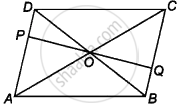Advertisements
Advertisements
प्रश्न
P and Q are points on opposite sides AD and BC of a parallelogram ABCD such that PQ passes through the point of intersection O of its diagonals AC and BD. Show that PQ is bisected at O.
उत्तर
Given: ABCD is a parallelogram whose diagonals bisect each other at O.
To show: PQ is bisected at O.

In ΔODP and ΔOBQ,
∠BOQ = ∠POD ...[Since, vertically opposite angles]
∠OBQ = ∠ODP ...[Alternate interior angles]
And OB = OD ...[Given]
∴ ΔODP ≅ ΔOBQ ...[By ASA congruence rule]
∴ OP = OQ ...[By CPCT rule]
So, PQ is bisected at O.
Hence proved.
APPEARS IN
संबंधित प्रश्न
Diagonals of a parallelogram `square`WXYZ intersect each other at point O. If ∠XYZ = 135° then what is the measure of ∠XWZ and ∠YZW?
If l(OY)= 5 cm then l(WY)= ?

The diagonals AC and BD of a parallelogram ABCD intersect each other at the point O. If ∠DAC = 32º and ∠AOB = 70º, then ∠DBC is equal to ______.
Diagonals of a quadrilateral ABCD bisect each other. If ∠A = 35º, determine ∠B.
In a parallelogram ABCD, AB = 10 cm and AD = 6 cm. The bisector of ∠A meets DC in E. AE and BC produced meet at F. Find the length of CF.
A diagonal of a parallelogram bisects one of its angles. Show that it is a rhombus.
In the following figure, AB || DE, AB = DE, AC || DF and AC = DF. Prove that BC || EF and BC = EF.

If the diagonals of a quadrilateral bisect each other, it is a ______.
If diagonals of a quadrilateral bisect each other, it must be a parallelogram.
Two sticks each of length 7 cm are crossing each other such that they bisect each other at right angles. What shape is formed by joining their end points? Give reason.
